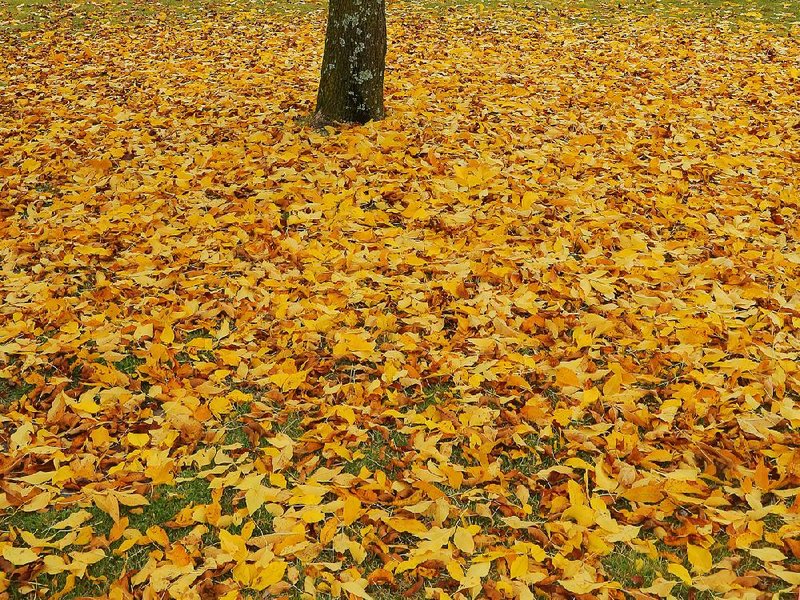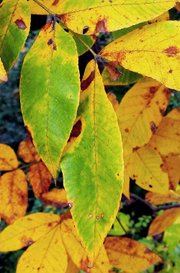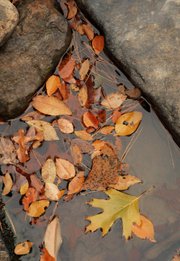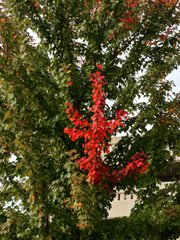"Next to nothing for weight,
And since they grew duller
From contact with earth,
Next to nothing for color.
Next to nothing for use.
But a crop is a crop,
And who's to say where
The harvest shall stop?"
-- Robert Frost
RELATED STORY
When the rain dried up this summer, Carla Davis started looking sideways at the trees.
"I was worried about this fall," the Little Rock resident said.
Months before fall?
"I was worried it was going to be all brown."
Every tree she has planted around her home in the Quapaw Quarter was selected for a fall show -- "not what color it is in the spring or if it flowers or not," she said. She has an "October Glory" maple that goes brilliant red-orange, a Japanese maple for dark red and three intense yellow ginkgoes.
As the drought dragged on into Little Rock's driest September since recordkeeping began in 1874, so did her concern. We're not talking about quiet desperation, but she admits to feeling "really upbeat" in the years her city puts on a show. It pleases her no end to share photos of glowing foliage with friends in more (err ...) populous states.
"It's just 'Look how lovely this place is,'" Davis said. "And, also, I think Arkansas gets a bad rap on many different things. Any time there's a tornado, of course you know who's out there telling what it sounded like. It's kind of nice to have something that's really great -- and better than a lot of places. It just makes me kinda proud that I live in a beautiful place."
For those who, like Davis, remembered that 2012 pulled out a brilliant fall despite a long drought, reassuring rain arrived the weekend of Oct. 23.
But then that rain landed with a thud heard around the state.
"Most of the leaves on my maple and Eastern redbuds all fell ... all of them," said Tamara Walkingstick, associate director of Arkansas Forest Resources with the University of Arkansas Division of Agriculture's Cooperative Extension Service.
Leaf litter on the ground is not considered a massive tourist draw.
But the week before the rain came, wildfire danger had been rated "high" in 53 counties. The National Weather Service issued a "Fire Weather Watch" for south, central and eastern Arkansas. While a bit of wildfire is generally good for forests, releasing nutrients and canceling germination inhibitors in some seeds, Walkingstick said, there is such a thing as too much -- say, the 28 wildfires that burned more than 500 acres Oct. 15 alone.
Instead of infernos everywhere, we got leaves in the gutter, not a bad trade-off. But many of those leaves were just changing from green to red or yellow. Why didn't they hang on to the branches?
Why give up so easily?
LEAVES MUST GO
Arkansans learn about the seasons in kindergarten, and second-graders learn leaf anatomy. By eighth grade we know that leaves are green because they make a green pigment, chlorophyll, and that photosynthesis feeds the plant.
Chlorophyll absorbs energy from light (blue and red wavelengths but not green, and that's why it's green). Leaves contain other light-absorbing pigments, yellow ones (xanthophylls) and orange ones (carotenoids), but the green masks them. Other pigments lurk in leaf cells, especially tannins, which are brown.
Exposed to sunlight, chlorophyll reacts with carbon dioxide (from the air) and water (from the tree) to create the carbohydrates schoolkids know as tree sugar. Meanwhile, lovely oxygen is freed to waft into the air. But the process is hell on chlorophyll. It must be perked up all the time, and that requires minerals provided constantly by the tree.
As summer dries out and drags toward shorter days and longer nights -- less sun -- less moisture moves up the tree to the leaf. Sugars bog down at the bottleneck where leaf stem meets twig; cells there take up the sugar and start to grow. These cells divide quickly but without expanding, becoming a thin, corky place called the abscission layer.
So "the process that starts the cascade of events that result in fall color is actually a growth process," according to an article from the United States National Arboretum, "The Science of Color in Autumn Leaves" (1.usa.gov/1salrib). That growth, though, causes the death of the leaf.
With the abscission layer blocking supplies from the tree, the leaf can't renew its chlorophyll and so -- right away -- green pigment breaks down into colorless compounds. Voila, we see the yellow and orange that were there all along. Cooler nighttimes make these colors shine. Meanwhile, in some trees, as nighttime temperatures fall, sugars trapped in the corked-off leaf react with other chemicals to create anthocyanins, pigments that give fall its reds and purples.
The best weather for a brilliant fall is a growing season with ample moisture so trees put on lots of leaves, followed by a dry, cool and sunny autumn with warm days and cooler but frost-free nights, Walkingstick said -- and no pummeling bouts of rain or wind. That abscission layer is thin and inflexible. A stiff breeze snaps it.
The drier the weather, the sooner the abscission layer forms. But in a drought, especially when nights are still warm, all the pigments except brown tannins break down.
"Brown is a color," Walkingstick said, helpfully.
She said researchers are trying to explain why the abscission process evolved so that some sugars remain in the leaf, allowing the creation of anthocyanins. But we already know why the leaf must die.
Frozen leaf cells explode into mush, like lettuce in the freezer. If they are to survive winter, plants must toughen up (pine needles are waxy, as are the leaves of live oaks) or sever their dependence on leaves before the cold hits.
Leaves die because they are a liability.
FOOD FOR THOUGHT
It's not precisely true that fallen leaves decay into food for the trees that made them. As David Montgomery explains in The Hidden Half of Nature: The Microbial Roots of Life and Health (see review on Page 1E), dead leaves are food for tiny things with teeth, which chew them into pieces small enough to feed smaller things, microbes, especially fungi. "Hungry soil life eats this organic bounty and in the process changes death into the elements and compounds that plants need but can't get from photosynthesis," he writes.
"It is symbiosis on a grand scale."
And it happens whether we notice or not. Humans can't take credit when the leaves change, and the forest benefits even when we don't like what the canopy looks like. So why do we care?
"Fall is a very distinct chapter in the year," said Carolyn Jenkins, a psychologist with the Arkansas Career Training Institute in Hot Springs, where her office window looks out on the autumn glories of West Mountain. She's a therapist for residents of the institute, which provides vocational training for people with disabilities.
Summer is "six months of green trees. Everything just kind of blends into itself," she said. But then "all of a sudden you look up one day and, hey. That tree is orange. How pretty is that?
"It forces us to just stop and look -- for a minute, look."
Physical beauty, unexpected, is arresting, demanding a pause from the busyness of workaday life: "This is nature in its full effect and full glory, and it's pretty." And it happens on a cycle, about the same time every year, encouraging people to revisit the moment and think, which gets deep thinkers' juices flowing.
"I don't know that everybody looks at the trees and thinks, 'Huh. I'm going to die someday,'" she said. "I think that's left to the poets." Still, the season "can teach us about letting go and moving on, and just the cycle of life. ...
"The fact is that it will go on whether you like it or not. The colors will be beautiful, maybe, or maybe you're just going to have brown and no colors. But whether you like it or not, it's going to happen. That does mirror our mortality, whether we like it or not."
She sees in fall a lesson on the value of letting go.
"In order for the trees to have new growth in the spring, we have to have a release of the leaves in the fall, and we go into a hibernation through the winter when things are dormant. And then in the spring things renew again. That is the cycle of life and ... our lives tend to mirror that.
"We have seasons of growth, and we have seasons of maintenance, and then we have a season where we have to let go," she said.
"We have to release things if we're going to make room for the new."
If a brown fall really bugs us, we could apply Photoshop or one of our other modern tools of denial to make the hills gleam more proudly in our panoramic photos. "But that's fabricated," Jenkins said.
"Do we want to live a fabricated life?"
ActiveStyle on 11/16/2015



